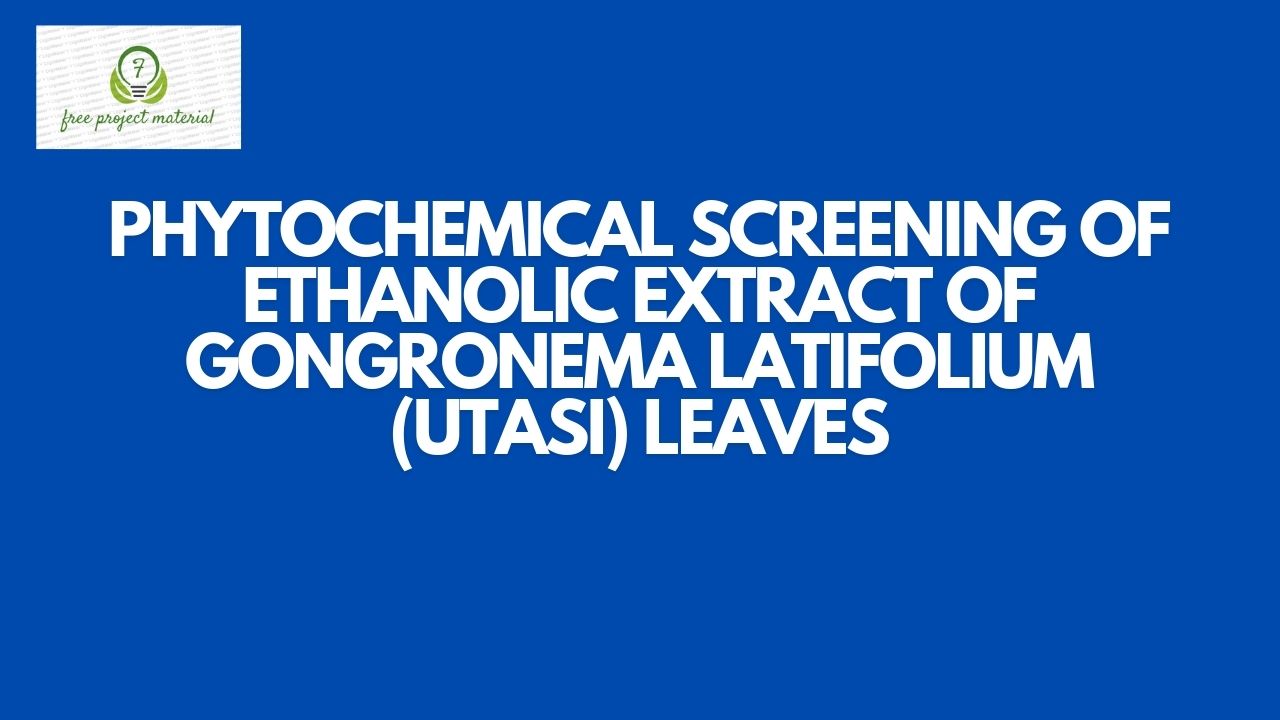ABSTRACT
The aim of this study was to determine the phytochemical screening of Gongronema latifolium leaves which was carried out using standing analytical methods. The result of the study showed that ethanol is a better extractive solvent. The leaf of Gongronema latifolium is found to contain alkaloids, flavonoids, saponins, glycosides and tannins. Furthermore, isolation, purification and characterization of the phytochemicals found present will make interesting studies.
TABLE OF CONTENTS
Title page – – – – – – – – –
Certification – – – – – – – –
Dedication – – – – – – – – –
Acknowledgement – – – – – – –
Abstract – – – – – – – – –
Table of Contents – – – – – – –
CHAPTER ONE: INTRODUCTION
1.1 Background of the study – – – – –
1.2 Aims and objective of the study – – – –
1.3 Scope and limitation of the study – – – –
1.4 Definition of terms – – – – – –
CHAPTER TWO: LITERATURE REVIEW
2.1 Botanical classification of Gongronema Latifolium –
2.2 Description of Gongronema Latifolium – – –
2.3 Origin and Destribution of Gongronema Latifolium –
2.4 Nutritional Value of Gongronema Latifolium – –
2.5 Uses of Gongronema Latifolium – – – –
2.6 Pharmacological Activities of Gongronema Latifolium – – – –
2.6.1 Anti-Microbial Activities of Gongronema Latifolium – – – – – –
2.6.2 Anti-bacterial Activities of Gongronema Latifolium – – – – – –
2.6.3 Anti-Oxidant effect of Gongronema Latifolium – –
2.7 Phytochemicals – – – – – – –
2.7.1 Alkaloid – – – – – – – –
2.7.2 Glycosides – – – – – – – –
2.7.3 Flavonoids – – – – – – – –
2.7.4 Saponin – – – – – – – –
2.7.5 Tannin – – – – – – – –
2.7.6 Phenol – – – – – – – –
CHAPTER THREE: MATERIALS AND METHOD
3.1 Collection of Sample/Preparation for Analysis –
3.2 Preparation of the extract – – – –
3.3 Phytochemicals screening – – – –
3.3.1 Test for Alkaloids – – – – –
3.3.2 Test for Glycosides – – – – –
3.3.3 Test for Flavonoids – – – – –
3.3.4 Test for Saponins – – – – – –
3.3.5 Test for Tannins – – – – – –
CHAPTER FOUR: RESULTAND DISCUSSION
4.1 Result – – – – – – –
4.2 Discussion – – – – – – –
CHAPTER FIVE: SUMMARY AND CONCLUSION
5.1 Summary – – – – – – –
5.2 Conclusion – – – – – – –
5.3 Recommendation – – – – – –
References
CHAPTER ONE
INTRODUCTION
1.1 BACKGROUND OF THE STUDY
Phytochemicals are chemical compounds produced by plants, generally to help them thrive or thwart competitors, predators or pathogens. The name comes from Greek word Phyto, meaning “Plant”. Some phytochemicals have been used as poisons and others as traditional medicines.
Phytochemicals under research can be classified into major categories, such as carotenoid and polyphenols. Heneman et al., (2008). The phytochemicals are used as functional food, soft drink, and many other food items, which are having good nutrient value, significant importance, and economically. To this in India, phytochemicals as well as medicinal plants, have remained the most abundant source of health care and life improvement for a long time. India is the richest source of traditional herbal plants with their prescriptions. In India, Ayurdedic, Unani and Siddha medicotherapeutics are playing a very important role in the society since ancient time. Ayurueda is approximately 5000 years old and predominantly uses phytochemicals in their preparation and formulations. Now in modern era, about 24%-27% drugs are derived from the plant sources. Several synthetic drugs also have been developed as the analogs/prototype of the natural phytochemicals, which serve as lead compounds for some synthetic drugs.
Phytochemicals is a broad term meaning plant (phyto) chemical referring to a wide variety of compounds that occur naturally in plants. Phytochemicals has been used to distinguish plant chemicals that do not meet the classical definition of “essential nutrients” some phytochemicals produce activity in biological systems, including humans; hence, the term has been defined phytochemicals as bioactive, non-nutrient compounds in fruits, vegetables, grains, and other plant foods that have been linked to reductions in the risk of major non-communicable chronic diseases.
Gongronema latifolium is a perennial edible plant with soft and pliable stem. It is widely used in West African sub-region for a number of medicinal and nutritional purposes. It belongs to the family of asdepiadaceae. Gongronema latifolium (whose leaves are bitter) is commonly called “Utazi” and “Grokeke” in south eastern and south western parts of Nigeria respectively. It is a tropical rainforest plant, primarily used as spice and vegetable in traditional folk medicine, Salvin et al (2012).
Medicinal plants have been the main stay of traditional herbal medicine amongst rural dwellers worldwide since antiquity to date. The therapeutic use of plant certainly goes back to the Sumerian and the Alkadian civilization in about the third millennium BC. Hippocrates (Ca. 460-377BC), one of the ancient authors who described medicinal natural products of plants and animal origins, listed approximately 400 different plant species for medicinal purposes. About 3.4 billion people in the developing world depend on plant-based traditional medicines. This represents about 88percent of the world’s inhabitants, who rely mainly on traditional medicine for their primary healthcare. According to the world health organization, a medicinal plant is any plant which, in one or more of its organs, contains substances that can be used for therapeutic purposes, or which are precursors for chemo-pharmaceutical semi synthesis, such a plant will have its parts including leaves, roots, rhizomes, stems, barks, flowers, fruits, grains or seeds, employed in the control or treatment of a disease condition and therefore contains chemical components that are medically active. These bioactive components are often referred to as phytochemicals (phyto from Greek-phyto meaning plant) or phyto constituents and are responsible for protecting the plant against microbial infection or infestation by pest Daughari et al., (2009).
The vital medicinal ingredients stored in the various parts of the Gongronema latifolium “Utazi) leaf can be extracted either through blending the fresh leaves, chewing the Gongronema latifolium (Utazi) seeds, leaves or fruits, infusing either the dry or fresh Gongronema latifolium leaves and decoction. However, these various methods of preparing and using the Gongronema latifolium (Utazi) leaves for medicinal purposes mainly depend on the part of the plant where the active medicinal ingredients are present. For example, the Gongronema latifolium roots cannot be chewed rather it has to undergo decoction, the leaves can be infused with hot water and allowed to cool down before drinking, while the fresh Gongronema latifolium leaves can be chewed. Afolabi F. (2007).
1.2 AIMS AND OBJECTIVES OF THE STUDY
The aim of this research work is to determine the phytochemical screening of ethanoic extract of Gongronema latifolium “Utazi” with the following objectives.
- To determine the phytochemical extract of alkaloid, glycoside, flavonoid, saponin, and tannin in Gongronema latifolium
- To compare the results of this analysis with the work of other researchers.
- To make recommendation and suggestion for further study based on the result obtain from this analysis.
1.3 SCOPE AND LIMITATION OF THE STUDY
This research project was focused on the phytochemical screening of ethanolic extract of Gongronema latifolium (Utazi). Meanwhile this research work focused only on the phytochemicals such as; Alkaloid, glycosides, flavonoids, saponin and tannin.
1.4 DEFINITION OF TERMS
Phytochemicals: This is defined as any chemical substance characteristics of plants or it may also be said that it is the chemistry of plants.
Screening: This is defined as the examination and treatment of a material to detect and remove unwanted fractions.
Extract: This is defined as a decoction, solution, or infusion made by drawing out from any substance that which gives it its essential and characteristics virtue. Or it may be defined as removing or obtaining a substance from something.
Gongronema latifolium: Gongronema latifolium commonly called Utazi and grokeke is a tropical rainforest plant primarily used as spice and vegetables in traditional folk medicine.


